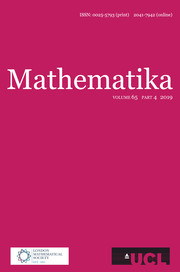Crossref Citations
This article has been cited by the following publications. This list is generated based on data provided by
Crossref.
Heppes, A.
1959.
Mehrfache gitterförmige Kreislagerungen in der Ebene.
Acta Mathematica Academiae Scientiarum Hungaricae,
Vol. 10,
Issue. 1-2,
p.
141.
Danzer, L.
1960.
Drei Beispiele zu Lagerungsproblemen.
Archiv der Mathematik,
Vol. 11,
Issue. 1,
p.
159.
T�th, G. Fejes
and
Florian, A.
1975.
Mehrfache gitterf�rmige Kreis- und Kugelanordnungen.
Monatshefte f�r Mathematik,
Vol. 79,
Issue. 1,
p.
13.
Blundon, W. J.
1977.
A Three-Fold Non-Lattice Covering.
Canadian Mathematical Bulletin,
Vol. 20,
Issue. 1,
p.
29.
Tóth, G. Fejes
1983.
Convexity and Its Applications.
p.
318.
1987.
Geometry of Numbers.
Vol. 37,
Issue. ,
p.
632.
Bezdek, András
and
Kuperberg, Włodzimierz
1997.
Circle Covering With a Margin.
Periodica Mathematica Hungarica,
Vol. 34,
Issue. 1-2,
p.
3.
Pach, János
Tardos, Gábor
and
Tóth, Géza
2007.
Discrete Geometry, Combinatorics and Graph Theory.
Vol. 4381,
Issue. ,
p.
135.
Fei, Xin
and
Boukerche, Azzedine
2008.
A performance evaluation of a coverage compensation based algorithm for wireless sensor networks.
p.
109.
Pach, János
Tardos, Gábor
and
Tóth, Géza
2009.
Indecomposable Coverings.
Canadian Mathematical Bulletin,
Vol. 52,
Issue. 3,
p.
451.
Fei, Xin
Samarah, Samer
and
Boukerche, Azzedine
2010.
A bio-inspired coverage-aware scheduling scheme for wireless sensor networks.
p.
1.
Zong, Chuanming
2014.
Packing, covering and tiling in two-dimensional spaces.
Expositiones Mathematicae,
Vol. 32,
Issue. 4,
p.
297.
PACH, JÁNOS
and
WALCZAK, BARTOSZ
2016.
Decomposition of Multiple Packings with Subquadratic Union Complexity.
Combinatorics, Probability and Computing,
Vol. 25,
Issue. 1,
p.
145.
Anna, Lempert
and
Mung, Le Quang
2018.
Multiple covering of a closed set on a plane with non-Euclidean metrics.
IFAC-PapersOnLine,
Vol. 51,
Issue. 32,
p.
850.
Yang, Qi
and
Zong, Chuanming
2019.
Multiple Lattice Tilings in Euclidean Spaces.
Canadian Mathematical Bulletin,
Vol. 62,
Issue. 4,
p.
923.
Kazakov, Alexander
Lempert, Anna
and
Le, Quang Mung
2020.
Mathematical Optimization Theory and Operations Research.
Vol. 1275,
Issue. ,
p.
120.


